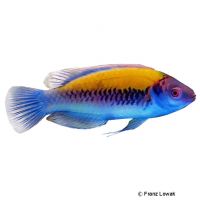Orangeback Fairy Wrasse (Cirrhilabrus aurantidorsalis)
| Orangeback Fairy Wrasse Cirrhilabrus aurantidorsalis | |
|---|---|
| Name | Orangeback Fairy Wrasse |
| Name Lat. | Cirrhilabrus aurantidorsalis |
| Family | Wrasses |
| Family lat. | Labridae |
| Order | Wrasses & Relatives |
| Order lat. | Labriformes |
| Origin | Western Pacific, Sulawesi |
| Habitat | Reefs |
| Diet | Planktivore |
| pH | 8,1-8,4 |
| Hardness | 8-10 °KH |
| Behavior | Peaceful |
| Keeping | Pair, harem |
| Reef Compatible | Yes |
| Care Level | Moderate |
| Life Span | N/A |
| Protection | No |
| Metric Units | |
| Size | 9 cm |
| Temperature | 24-28 °C |
| Salinity | 33-36 ‰ |
| Aquarium | ~ 350 l |
| US Units | |
| Size | 3" |
| Temperature | 75-82 °F |
| Salinity | 1.020-1.025 sg |
| Aquarium | ~ 90 gal |
Distribution and habitat
The distribution area of Cirrhilabrus aurantidorsalis is exclusively the Gulf of Tomini near Sulawesi (Indonesia). There they live mostly in small groups in the rubble of the reef edges with coral growth in 15-30 m depth, schools of juveniles also in shallower water.
Maintenance
They require a well-structured aquarium with plenty of swimming space and a reef structure (hiding, resting and retreat possibilities) with living stones that act like a biological filter. Only lime-rich, heavy metal-free substrates may be used as substrate.
Filters, skimmers and heaters are necessary to ensure water quality, as well as pumps to simulate tides, swells and bottom currents. Lighting must match the species-appropriate day-night rhythm of the animals
| Salinity: 33-36 ‰ | pH value: 8.1-8.4 |
| Carbonate hardness: 8-10 °KH | Nitrate content: 2-8 mg/l |
| phosphate content: 0.01-0.1 mg/l | nitrite content: 0.0-0.05 mg/l |
For salinity, an average value should be aimed for, which may only vary slightly by +/- 0.5 ‰. Ammonia and ammonium must not be measurable. Special attention must be paid to constantly good water quality.
Diet
In nature they feed mainly on zooplankton. The feed change usually succeeds without problems. The food supply for these slow eaters should consist of a commercially available, vitamin-enriched frozen special food mix for plankton eaters or a combination of chopped shrimp and crab meat with live and frozen foods such as mysis, krill, bosmids, cyclops and Artemia. High quality flake and granular foods are also often accepted after a period of acclimation. It is recommended to feed small portions several times a day (3-5 times). This also reduces intra-species aggression.
Regular and varied feeding promotes health and increases resistance.
Behaviour and compatibility
The young fish, mostly females, are peaceful among themselves and can be kept without problems. With the sex change to male the aggression increases. Only one male should be kept with one or more females. Several animals can be socialized well, if they are put into the aquarium at the same time. Towards other fish they behave peacefully.
Sex dimorphism
They are protogynous hermaphrodites, i.e. most males develop from functional females. The males are more orange on the back with a dark red crown.
Reproduction and breeding
There are no known reports of successful breeding in the aquarium.
Important
They are easily confused with Cirrhilabrus solorensis, with which they often interbreed
They do not burrow like other wrasses and coloration can vary according to their mood. Since they occasionally jump, make sure the aquarium is well covered
They do very well in a reef aquarium with corals and invertebrates and should not be kept in a fish-only aquarium
If different species are kept together, care should be taken to match the fish in terms of water quality and temperature requirements and social behavior, and to ensure that the setup meets the needs of all species kept together. New fish to be introduced must be acclimated slowly to the water in the aquarium
Further literature can be found in your pet store.
References
Text: Werner Winter; Image: Franz Lowak
Source: KUITER, DEBELIUS (2007): Atlas der Meeresfische: Die Fische an den Küsten der Weltmeere, Kosmos Verlag; ENGELMANN (2005): Zootierhaltung - Tiere in menschlicher Obhut: Fische, Verlag Harri Deutsch
- Gemäß § 21 Abs. 5 Tierschutzgesetz idgF
